This article was medically reviewed by Pradeep Adatrow, DDS, MS. Dr. Pradeep Adatrow is the only board certified Dentist, Periodontist, and Prosthodontist in the southern United States. With over 15 years of experience, Dr. Adatrow specializes in dental implants, TMJ treatments, periodontal plastic surgery, surgical and non-surgical periodontics, bone regeneration, laser treatments, and soft tissue and gum graft procedures. He received a BS in Epidemiology and Biostatistics from the University of Alabama and earned his Doctor of Dental Surgery (DDS) degree from the University of Tennessee College of Dentistry. Dr. Adatrow then completed a three-year postgraduate program in periodontics and implantology at Indiana University and went on to complete another three-year postdoctoral program in advanced prosthodontics from the University of Tennessee. He also serves as a full-time professor and the Director of Surgical Prosthodontics at the University of Tennessee. Dr. Adatrow received the Dean's Junior Faculty Award and the John Diggs Faculty Award, and he was inducted into the Deans Odontological Society. He is board certified by the American Board of Periodontology and is a Fellow of the prestigious International College of Dentistry – a feat that only 10,000 others worldwide can claim.
This article has been viewed 85,487 times.
A toothache is typically caused by a cavity or another untreated infection in the mouth. Once this infection—and the permanent tooth damage that it causes—works its way through your tooth and hits the nerve, it can be quite painful. Toothaches can also be caused by a cracked tooth, a loose filling (especially if another cavity has formed below the loose filling), or an abscess (infection at the gumline, which affects the bone).Although it’s important to see your dentist as soon as possible for any of these conditions, you may not be able to schedule an appointment as soon as the pain hits. To hold off tooth pain temporarily, whether to fall asleep for a night or just to get through the day, you’ll need to numb the nerve of the tooth.
Steps
Using Medication to Numb a Tooth
-
1Take an over-the-counter-painkiller. A painkiller like ibuprofen or acetaminophen should be your first step in trying to numb a painful tooth.[1] These painkillers will alleviate the pain from your tooth, and should also decrease any swelling in the infected area. These are all readily available at your local pharmacy.
- If you’re treating a toothache in a child younger than 18, do not give him or her aspirin. This medication can cause Reye’s syndrome in children and teens.
- Do not exceed the maximum dose required when taking an over-the counter painkillers and be aware of the potential adverse reactions or allergies, which can include severe internal bleeding.
-
2Apply benzocaine directly to the painful area. Benzocaine is a numbing gel that can be purchased over the counter at any pharmacy or drug store. Although the effects of this gel are temporary, it will effectively decrease tooth pain by numbing the sensitive, inflamed, and infected tissue.[2]
- The inside of your mouth is naturally a wet place, and this moisture will cause the Benzocaine to wear off quickly. To prolong the effect, first dry the painful area with a clean cloth, and then apply the numbing gel to the dry area.
- Over time, the Benzocaine will be diluted and wear off. To prolong its effect, do not lick at the numb area, and do not prod the numb area with your fingers. Do not swallow the medicine either or it will numb your throat. Check and see if your gums hurt or if you notice anything from using the gel. If something goes wrong, stop using it.
Advertisement -
3Rinse the painful area with hydrogen peroxide. This will temporarily numb the toothache, and can also kill some of the bacteria in your mouth that are causing the infection. Purchase 3% hydrogen peroxide from your local drugstore or pharmacy, and mix with water at a 1:1 ratio. Swish this in your mouth until you feel the pain start to numb.[3]
- Spit the peroxide out; never swallow it. Hydrogen peroxide can be very unhealthy if swallowed.
- You can also rinse your mouth with straight hydrogen peroxide, as long as you then rinse with water several times. Use this no more than three times a day and never more than five days in a row because hydrogen peroxide can cause teeth sensitivity.
Numbing a Tooth with Natural Remedies
-
1Apply a few drops of clove oil to the tooth. Clove oil will help alleviate some of the inflammation in your tooth, and it may kill bacteria. The oil will also numb the area it’s applied to, as the oil contains the chemical eugenol, which functions as a local anesthetic.[4]
- Place a small amount of the oil on a clean cotton ball and apply it to the infected area. If it seems too solid, dilute the clove oil with a few drops of water first.[5]
- Clove oil can be purchased at your local pharmacy or drugstore.
-
2Apply a mix of powdered ginger and cayenne pepper to the aching tooth. Combine the powdered ginger and cayenne in a bowl at a 1:1 ratio, add a couple of drops of water, and stir into a paste. Saturate a cotton ball (or a corner of a clean cotton cloth) in the paste, and then apply directly to your aching tooth.[6] This mixture will have a similar effect to the clove oil and will numb the pain from your toothache.
- Both powdered ginger and cayenne pepper can be purchased in the spice section of your local grocery store.
- Do not use fresh or raw ginger, as the mixture needs to be powdered.
- Make sure to apply this mixture directly to the tooth to calm down the nerve pain. If you get cayenne pepper on your gums or tongue, it will cause a burning sensation on the sensitive tissue.
-
3Rinse your mouth with salt water. Salt will cleanse the inside of your mouth and can kill some of the bacteria infecting your tooth, and can also provide temporary numbness and pain relief. Warm a glass of tap water, and add a teaspoon of salt, then stir to dissolve the mixture. Once the salt has dissolved, swish the salt water in your mouth for 30–60 seconds.[7] If the pain is not sufficiently numbed after the first rinse, repeat as often as needed. You may find that cold or warm water works better for you, so use the temperature that works for you.
- Make sure to spit the salt water into the sink. Ingesting excessive salt can be unhealthy.
Applying Numbing Material Directly to Your Tooth
-
1Hold a small plastic bag of ice to your tooth. This works best if you do not apply ice directly to the tooth, so place 3–4 cubes in a plastic bag, wrap a clean cotton cloth around the bag, and then apply directly to your aching tooth. The ice should be held in place for at least 15 minutes, and will provide temporary relief for the pain.[8] Repeat as often as necessary.
- If your aching tooth is near the front of your mouth, you should be able to apply the ice directly to the base of the tooth. If the tooth is nearer the back of your mouth, you’ll need to press the ice against your cheek in the area closest to the painful tooth.
-
2Hold a warm, damp black tea bag against the painful tooth. While you don’t need to have made a cup of tea with this teabag, it should be wet before you apply it to the tooth. Use black tea, as it contains astringent tannins, which will decrease both pain and swelling around your infected tooth.[9]
- To wet the tea bag, dip it in a glass of warm water for about 5 seconds.
- Hold the tea bag inside your mouth for 10 to 15 minutes, or until the pain begins to numb. Just don’t use too much pressure, such as by biting on the teabag.
-
3Place a piece of already-chewed gum over a broken tooth. While this remedy will not numb the tooth or decrease the pain from toothache, it can prevent a broken tooth—or a tooth with a loosened or missing filling—from fracturing further. Chew the gum on the side of your mouth away from the aching tooth, and then gently press the gum over the broken tooth.[10]
- If possible, use sugar-free gum. The sugar in regular gum could work its way into the broken tooth and accelerate the decay, whereas sugar-free gum will not harm the tooth.
- Avoid eating with the broken tooth, as this can be very painful, and will also further harm the tooth.
Expert Q&A
Did you know you can get expert answers for this article?
Unlock expert answers by supporting wikiHow
-
QuestionWhat is the fastest way to stop a toothache at home?
 Pradeep Adatrow, DDS, MSDr. Pradeep Adatrow is the only board certified Dentist, Periodontist, and Prosthodontist in the southern United States. With over 15 years of experience, Dr. Adatrow specializes in dental implants, TMJ treatments, periodontal plastic surgery, surgical and non-surgical periodontics, bone regeneration, laser treatments, and soft tissue and gum graft procedures. He received a BS in Epidemiology and Biostatistics from the University of Alabama and earned his Doctor of Dental Surgery (DDS) degree from the University of Tennessee College of Dentistry. Dr. Adatrow then completed a three-year postgraduate program in periodontics and implantology at Indiana University and went on to complete another three-year postdoctoral program in advanced prosthodontics from the University of Tennessee. He also serves as a full-time professor and the Director of Surgical Prosthodontics at the University of Tennessee. Dr. Adatrow received the Dean's Junior Faculty Award and the John Diggs Faculty Award, and he was inducted into the Deans Odontological Society. He is board certified by the American Board of Periodontology and is a Fellow of the prestigious International College of Dentistry – a feat that only 10,000 others worldwide can claim.
Pradeep Adatrow, DDS, MSDr. Pradeep Adatrow is the only board certified Dentist, Periodontist, and Prosthodontist in the southern United States. With over 15 years of experience, Dr. Adatrow specializes in dental implants, TMJ treatments, periodontal plastic surgery, surgical and non-surgical periodontics, bone regeneration, laser treatments, and soft tissue and gum graft procedures. He received a BS in Epidemiology and Biostatistics from the University of Alabama and earned his Doctor of Dental Surgery (DDS) degree from the University of Tennessee College of Dentistry. Dr. Adatrow then completed a three-year postgraduate program in periodontics and implantology at Indiana University and went on to complete another three-year postdoctoral program in advanced prosthodontics from the University of Tennessee. He also serves as a full-time professor and the Director of Surgical Prosthodontics at the University of Tennessee. Dr. Adatrow received the Dean's Junior Faculty Award and the John Diggs Faculty Award, and he was inducted into the Deans Odontological Society. He is board certified by the American Board of Periodontology and is a Fellow of the prestigious International College of Dentistry – a feat that only 10,000 others worldwide can claim.
Board Certified Dentist & Oral Surgeon You can hold a bag of frozen vegetables to the side of your face for about 20 minutes at a time. Just put a cloth between your skin and the cold bag so your face doesn't get too cold. You could also opt for an anti-inflammatory like ibuprofen, which will help reduce swelling and pain. If you don't have that, take acetaminophen—it's not an anti-inflammatory, but it will help alleviate pain.
You can hold a bag of frozen vegetables to the side of your face for about 20 minutes at a time. Just put a cloth between your skin and the cold bag so your face doesn't get too cold. You could also opt for an anti-inflammatory like ibuprofen, which will help reduce swelling and pain. If you don't have that, take acetaminophen—it's not an anti-inflammatory, but it will help alleviate pain. -
QuestionAre there any natural ways to numb a toothache?
 Pradeep Adatrow, DDS, MSDr. Pradeep Adatrow is the only board certified Dentist, Periodontist, and Prosthodontist in the southern United States. With over 15 years of experience, Dr. Adatrow specializes in dental implants, TMJ treatments, periodontal plastic surgery, surgical and non-surgical periodontics, bone regeneration, laser treatments, and soft tissue and gum graft procedures. He received a BS in Epidemiology and Biostatistics from the University of Alabama and earned his Doctor of Dental Surgery (DDS) degree from the University of Tennessee College of Dentistry. Dr. Adatrow then completed a three-year postgraduate program in periodontics and implantology at Indiana University and went on to complete another three-year postdoctoral program in advanced prosthodontics from the University of Tennessee. He also serves as a full-time professor and the Director of Surgical Prosthodontics at the University of Tennessee. Dr. Adatrow received the Dean's Junior Faculty Award and the John Diggs Faculty Award, and he was inducted into the Deans Odontological Society. He is board certified by the American Board of Periodontology and is a Fellow of the prestigious International College of Dentistry – a feat that only 10,000 others worldwide can claim.
Pradeep Adatrow, DDS, MSDr. Pradeep Adatrow is the only board certified Dentist, Periodontist, and Prosthodontist in the southern United States. With over 15 years of experience, Dr. Adatrow specializes in dental implants, TMJ treatments, periodontal plastic surgery, surgical and non-surgical periodontics, bone regeneration, laser treatments, and soft tissue and gum graft procedures. He received a BS in Epidemiology and Biostatistics from the University of Alabama and earned his Doctor of Dental Surgery (DDS) degree from the University of Tennessee College of Dentistry. Dr. Adatrow then completed a three-year postgraduate program in periodontics and implantology at Indiana University and went on to complete another three-year postdoctoral program in advanced prosthodontics from the University of Tennessee. He also serves as a full-time professor and the Director of Surgical Prosthodontics at the University of Tennessee. Dr. Adatrow received the Dean's Junior Faculty Award and the John Diggs Faculty Award, and he was inducted into the Deans Odontological Society. He is board certified by the American Board of Periodontology and is a Fellow of the prestigious International College of Dentistry – a feat that only 10,000 others worldwide can claim.
Board Certified Dentist & Oral Surgeon
Warnings
- A painful tooth will progressively worsen the longer it goes without professional dental treatment.⧼thumbs_response⧽
- Avoid reliance on home remedies as a long-term solution. While home remedies may numb tooth pain temporarily, you should still schedule an appointment with your dentist to have the tooth examined or removed as soon as possible.⧼thumbs_response⧽
- Never attempt any kind of dental work at home.⧼thumbs_response⧽
References
- ↑ https://healdove.com/oral-health/The-Best-Medications-to-Stop-Tooth-Pain-Fast
- ↑ https://my.clevelandclinic.org/health/drugs/20991-benzocaine-mouth-gel-ointment-solution-or-dental-paste
- ↑ https://www.stpetedentist.com/blog/home-remedies-for-toothaches-that-actually-work/
- ↑ http://www.besthealthmag.ca/best-you/home-remedies/natural-home-remedies-toothache/
- ↑ Pradeep Adatrow, DDS, MS. Board Certified Dentist & Oral Surgeon. Expert Interview. 5 November 2020.
- ↑ http://www.besthealthmag.ca/best-you/home-remedies/natural-home-remedies-toothache/
- ↑ Pradeep Adatrow, DDS, MS. Board Certified Dentist & Oral Surgeon. Expert Interview. 5 November 2020.
- ↑ https://www.stpetedentist.com/blog/home-remedies-for-toothaches-that-actually-work/
- ↑ http://www.besthealthmag.ca/best-you/home-remedies/natural-home-remedies-toothache/
About This Article
Tooth pain isn't fun and you should see your dentist as soon as possible so they can help you treat it. But, in the meantime, you can numb your tooth by rinsing your mouth with salt water for 30 to 60 seconds. Or, wrap 3 or 4 ice cubes in a small plastic bag and a cloth and hold it to your painful tooth. Hold it for 15 minutes at a time as often as you need to. Another way to numb your tooth naturally is with a damp black tea bag. Just hold the bag against your tooth for 10 to 15 minutes. If that doesn’t work, try an over-the-counter painkiller, like ibuprofen or acetaminophen. For more tips from our Dental co-author, including how to protect a broken tooth while you wait to see your dentist, read on.
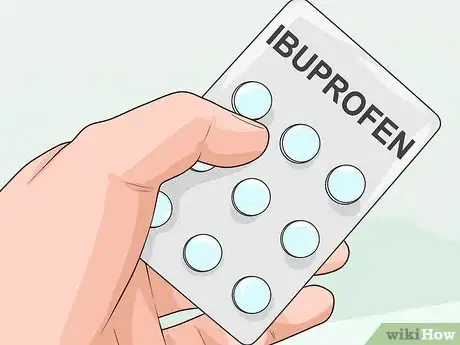
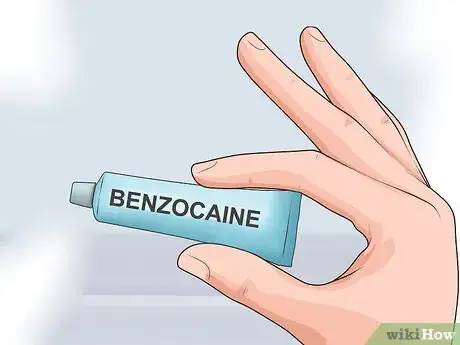
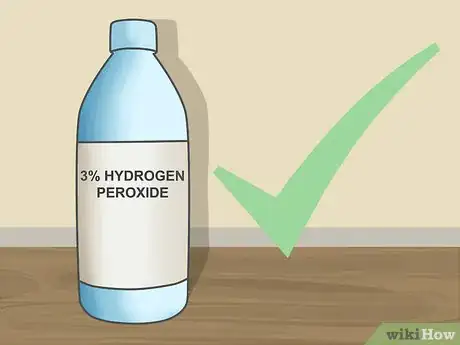
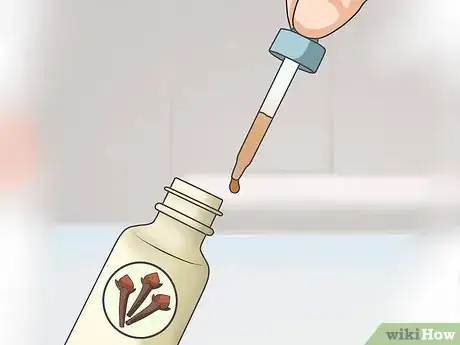

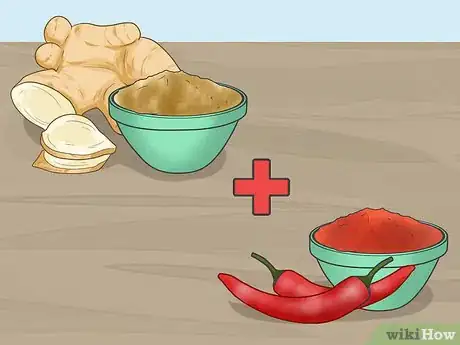
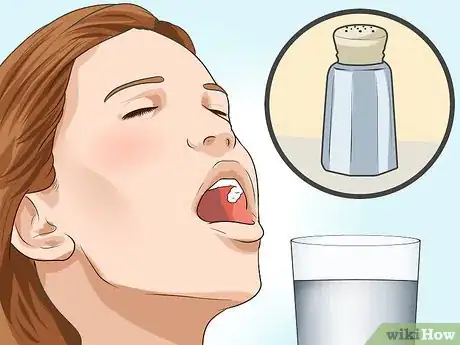
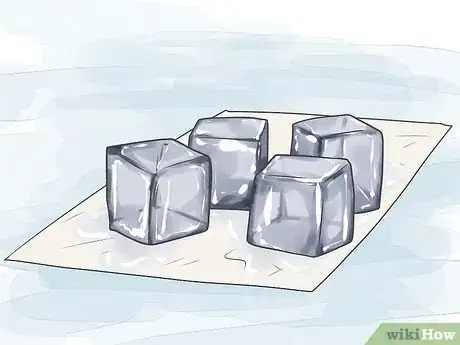



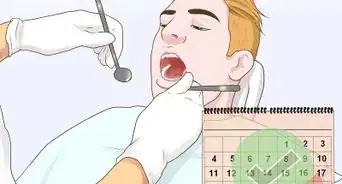

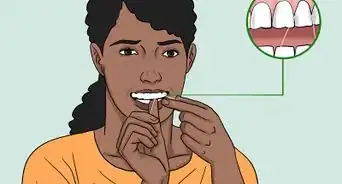
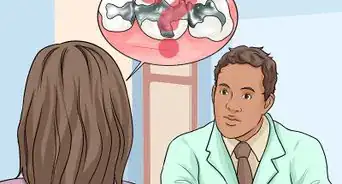





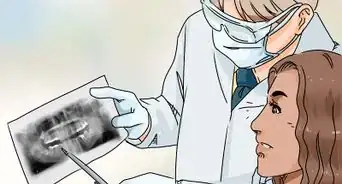


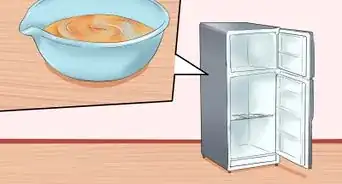










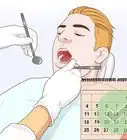

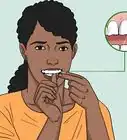



































Medical Disclaimer
The content of this article is not intended to be a substitute for professional medical advice, examination, diagnosis, or treatment. You should always contact your doctor or other qualified healthcare professional before starting, changing, or stopping any kind of health treatment.
Read More...